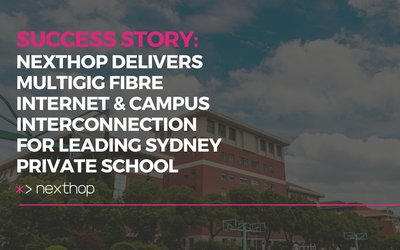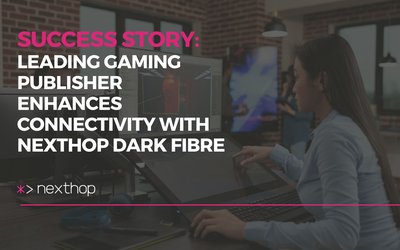Digital infrastructure is the modern company's backbone and has therefore very much changed end-users' minds about connection, which is now regarded as a premium strategic investment rather than just a simple IT decision. Opting for the right fibre connectivity solution – Fibre to the Building (FTTB), Dark Fibre or Wavelength services, to name a few – is not merely about acquiring faster speeds. Each option comes with its own set of advantages and disadvantages in terms of cost structure, performance, and operational management.
The selection is made according to how it coincides with your company's financial model, operational capabilities, and long-term growth plans. The article brings to light the significant trade-offs of fibre connectivity options in terms of cost structures, performance, and degrees of control, thus guiding the organisations to make informed and strategic decisions.
Cost Structure and Control: CapEx vs. OpEx
FTTB and Wavelengths: The Operational Expenditure (OpEx) Model
Fibre to the Building (FTTB) and Wavelength services are both OpEx-driven, meaning they are ideal for less risk-taking companies that prefer predictable monthly payments instead of huge one-time investments.
FTTB is a shared retail service, but it still delivers a fast and reliable connection to the network at the lowest cost. The provider does everything: installation, maintenance, and bandwidth allocation. Therefore, with the FTTB business, the organisations keep paying monthly and do not buy or own their own optical equipment; it is thus good for those who want to have less operational responsibility. However, since FTTB is using shared infrastructure, there will be times of slow performance, especially in peak hours, so it is a trade-off between convenience and control with no guarantee of capacity.
Wavelength services, on the other hand, occupy the upper end of the OpEx spectrum. Instead of fibre sharing, the companies buy a dedicated optical wavelength—a sole "lane" of light—on the provider's pre-existing fibre network. This will guarantee symmetrical bandwidth, low latency, and tight Service Level Agreements (SLAs) for uptime and performance. While wavelengths have a higher recurring cost than FTTB, they offer carrier-grade reliability and constant performance without requiring any optical equipment. For a lot of companies, they help to strike the right balance between guaranteeing performance and operational simplicity; thus, they are perfect for inter-data centre connections and mission-critical workloads.
Dark Fibre: The Capital Expenditure (CapEx) and Control Model
Dark Fibre is a communication technology that requires a lot of investment but is perfect for companies that need to have total control of their networks and long-term scalability. When a corporation opts for Dark Fibre, it gets the unused (unlit) optical fibres, and it gets to decide the technology for lighting the fibre up, usually with DWDM (Dense Wavelength Division Multiplexing) or CWDM (Coarse Wavelength Division Multiplexing) systems.
The company has to invest heavily in hardware, installation, and technical know-how to pull this option off. However, the returns are control, flexibility, and performance that no other vendor can match. The business can design its optical network, choosing everything from routing and encryption to performance requirements, and will not be restricted by any carrier's limitations.
The initial investment is high, but Dark Fibre offers the lowest cost per bit at a large scale and positions the company for a solid long-term return. The life of the infrastructure often surpasses two decades, and over time the capacity can be scaled up as well—from 100G to 800G—without replacing the fibre. The companies that have the funds and know-how to operate their network will see connectivity not as a regular service expenditure but as a strategic infrastructure asset through Dark Fibre.
Performance and Latency Trade-offs
Contention and Predictability (FTTB vs. Wavelength)
Cost-effective and fast, FTTB can offer great speeds; however, it is prone to the pitfall of shared infrastructure in that performance is likely to be adversely impacted during the peak demand times. In addition, the bandwidth of the service is split among several users, which creates contention and leads to the area being slowed down during high demand. This might be a drawback for small offices or businesses with moderate bandwidth needs, but data-intensive activities would find such fluctuation quickly turning into a bottleneck.
On the other hand, wavelength services eliminate such conflicts by providing dedicated optical channels between the endpoints. All businesses are allocated the same and fixed bandwidth, and this is reinforced by stringent Service Level Agreements (SLAs) regarding their latency, jitter, and availability quality. Not only is it ensured that performance is always constant and predictable, but also real-time analytics, cloud replication, video streaming, and financial trading, where every millisecond is critical, can operate without interruption.
The pairing of performance guarantee and uncomplicated operation that wavelength services deliver is perfect for the companies that demand a carrier-grade level of reliability yet still do not want to deal with the complications of managing fibre infrastructure.
The Speed of Light and Raw Performance (Dark Fibre)
Dark Fibre is the top-notch solution with regard to performance. Since the optical equipment is owned by the company, the network can be designed with low latency, high throughput and custom routing paths according to its operational needs.
On the other hand, managed services are confined to the architecture of the provider, whereas a Dark Fibre network gives complete flexibility. Organisations can implement the latest optical technology, like 800G transponders, complicated modulation schemes and quantum-safe encryption instantly without depending on a carrier’s upgrade cycle.
To sum up, Dark Fibre provides a blank optical canvas for enterprises to illuminate, scale, and optimise according to their own requirements. For sectors where speed is the main factor that determines the winner, like financial trading, hyperscale cloud or media production, this kind of power guarantees the quickest performance possible and promotes innovation at a rapid pace.
Operational Control and Scalability
Operational Responsibility and Internal Expertise
The extent of operational responsibility that the business has to take on at the hands of FTTB, Wavelength, and Dark Fibre varies quite a lot.
On the provider's side, FTTB is as good as one hundred percent because the provider will be responsible for every aspect of the service, from provisioning, monitoring, and fault resolution to service continuity. The end-user is simply buying a bandwidth service, thus making it an ideal solution for businesses having no technical staff or for those wanting an utterly managed and "hands-off" experience.
The Wavelength service has a similar managed model. The telecommunications company looks after the fibre, the optical devices, and the availability of the service, while the customer's role is limited to the configuration of the endpoint and the monitoring of the SLA. So, companies can have a smooth operation and not worry about managing the infrastructure.
On the other hand, Dark Fibre requires a lot of in-house expert knowledge or at least a managed service provider for collaboration to perform network monitoring, maintenance, device lifecycle management, and fibre repair coordination. Even though this means that more operational responsibility is imposed, it is also true that complete control and sovereignty over the network environment are given. For tech companies, this compromise results in unparalleled autonomy, flexibility, and long-term value.
Unlimited Bandwidth Growth Potential
Scalability is another aspect where Dark Fibre technology surpasses the conventional connectivity technologies. The first thing that comes to mind when talking about fibre deployment and its connection is its capacity, which is practically unlimited. The only boundaries to these capabilities are the light technology used to shine on the fibre. With the introduction of new standards and transponders, the capacity can be uplifted dramatically without altering anything in the network physically.
On the other hand, wavelengths are generally restricted to the contractual limits, which might be 10G, 100G, or 400G. In order to upgrade to higher bandwidth, it is usually necessary to renegotiate the contract, provide new wavelengths, and incur higher recurring costs.
FTTB, as a shared service, is the least scalable option. Higher-speed tiers may be offered by the providers, but they are still restricted by the shared infrastructure model, where the performance boost is limited by both physical and network design.
Notwithstanding Dark Fibre's unlimited bandwidth potential, it still fits the needs of organisations that want to be digitally long-term, like data centres, cloud providers and large research institutions.
The selection of FTTB, Dark Fibre, and Wavelengths is determined by the giving up of the OpEx simplicity for the CapEx control. Although FTTB offers the lowest initial cost and maintains low operating expenses, it has limitations in control and lacks the potential for expansion. On the other hand, Wavelengths deliver steady performance and, at the same time, provide prices that can be set and known in advance, but they do require a certain amount of dependence on the supplier for equipment and maintenance. Dark Fibre comes with very high performance, enormous capacity for expansion, and full control, but, at the same time, a hefty upfront investment and skilled manpower are necessary.
When it comes to making a decision regarding FTTB, Dark Fibre, and Wavelength services, companies have to consider their fixed asset spending tolerance versus that of their operating expense, the extent of network control they wish to have, and their bandwidth requirements in the long run. Don't hesitate to reach out to the Nexthop Team in case of enquiries about your specific needs and in getting the best-fit option for your organisation.






